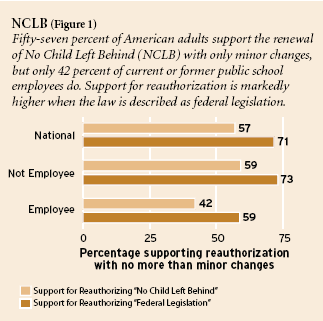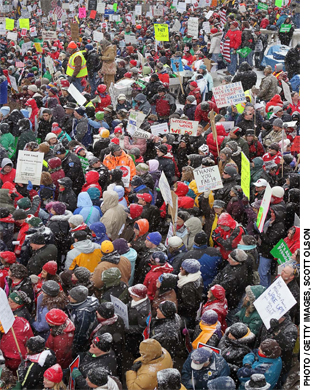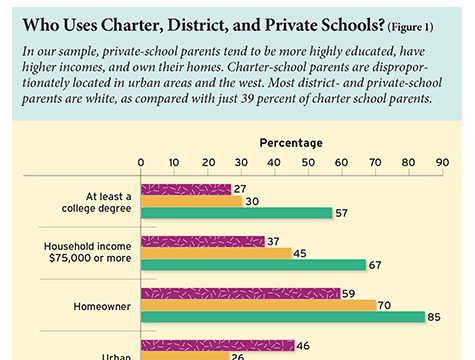 In the contentious world of education politics, the need to spend more on public schools stands out as a rare point of agreement. Our recent national survey of American adults (“What Americans Think about Their Schools,” features, Fall 2007) found that those who support increased spending on public schools in their district outnumber those who want spending to decrease by a five-to-one margin. What’s more, a solid majority (59 percent) of Americans express confidence that spending more on the public schools in their district will increase student learning.
In the contentious world of education politics, the need to spend more on public schools stands out as a rare point of agreement. Our recent national survey of American adults (“What Americans Think about Their Schools,” features, Fall 2007) found that those who support increased spending on public schools in their district outnumber those who want spending to decrease by a five-to-one margin. What’s more, a solid majority (59 percent) of Americans express confidence that spending more on the public schools in their district will increase student learning.
Our findings paralleled those of other surveys, which routinely show that Americans rank inadequate funding among the most important problems facing the nation’s schools. According to the 2007 Phi Delta Kappa/Gallup poll, for example, 22 percent of U.S. adults identified a lack of financial support as the biggest problem facing the schools in their community. The second-ranked problem, a lack of discipline, was mentioned by only one in ten respondents. It is no surprise, then, that every Democratic candidate for the presidency in 2008 has called for increased federal spending on education, and that no Republican candidate (with the exception of libertarian Ron Paul) has proposed a spending cut.
Yet while the public’s views about spending on education are well known, the same cannot be said about the information on which those views are based. Do Americans have an accurate grasp of how much is currently being spent on public education?
The 2007 Education Next–PEPG Survey directly addressed this question. In addition to asking Americans whether school spending should be increased, we asked them to estimate both per-pupil expenditures in their districts and teacher salaries in their states. We then used data on actual spending and salaries, matched geographically to each respondent’s school district or state, to compare the public’s perceptions with reality.
The results are striking: Americans dramatically underestimate the amount spent on the public schools in their district, even when prompted to consider the full range of uses to which school spending is devoted. They also think that teachers earn, on average, far less than is actually the case. The public’s strong preference that more be spent on public schools is based, at least in part, on faulty information.
Measuring Knowledge about Spending
In February and March of 2007, we surveyed a nationally representative sample of 2,000 American adults about a wide range of education issues. (For overall results, see “What Americans Think about Their Schools”) Within an extensive battery of questions, we included the following: “Based on your best guess, what is the average amount of money spent each year for a child in public schools in your school district?”
Half of the sample, randomly chosen, was also offered a prompt to encourage them to consider the full range of costs associated with educating a child. These respondents were told that “Individual student costs go toward teacher and administrator salaries, building construction and maintenance, extracurricular activities, transportation, etc.” With this prompt, we anticipated, respondents would have an easier time answering the question.
We also asked people to estimate the average annual salary of a public school teacher in their state. We asked about teacher salaries at the level of the state, rather than the specific district, because that is the lowest level of aggregation for which information on actual salaries is readily available nationwide. With information about where survey respondents lived, we then compared their answers to actual per-pupil expenditures in their districts and to teacher salaries in their states in 2004–05, the most recent year for which this information is available (see methodology sidebar, below).
MethodologyFor the analyses of per-pupil expenditures, we matched survey respondents to school districts using either census blocks or zip codes. When we relied on zip codes, we could not match some respondents to a unique school district. For such respondents we calculated the average per-pupil spending levels for each district that served the relevant zip code, weighted by districts’ population sizes. Teacher salary data, by contrast, are available only at the state level. We were able to match all survey respondents to the states in which they resided. Data on per-pupil spending come from the National Center for Educational Statistics Common Core of Data, “Local Education Agency Finance Survey.” Data on teacher salaries come from the American Federation of Teachers publication, “Survey and Analysis of Teacher Salary Trends 2005.” Both sources cover the 2004–05 academic year, the latest for which this information is available. The two-year lag between 2004–05 and the time we conducted our survey should lead respondents to overestimate actual expenditures, as spending on public schools tends to increase over time. On any survey item, there are likely to be some respondents who either misunderstand the question or, for one reason or another, choose not to take it seriously. To ensure that such responses would not cloud our analysis, we eliminated 21 answers of zero to the spending question and another 25 of zero to the salary question. We also eliminated 18 answers of more than $50,000 for per-pupil spending and 17 answers of more than $100,000 for average teacher salaries. In the end, we were left with 1,926 valid responses for per-pupil spending, of which we were able to match 1,656 to districts with available spending information, and 1,932 valid responses on teacher salaries, of which we were able to match 1,911 to states with available salary information. |
Not Even Close
The amount of money actually spent annually on children in school districts across the United States varies widely. For the districts in which our sample members live, per-pupil spending in 2004–05 ranged from $5,644 to $24,939,with an average of $10,377. This last figure is slightly higher than the true national average of $9,435.
How well informed is the public about these financial commitments? Not very. Among those asked without the prompt listing possible expenses, the median response was $2,000, or less than 20 percent of the true amount being spent in their districts. Over 90 percent of the public offered an amount less than the amount actually spent in their district, and more than 40 percent of the sample claimed that annual spending was $1,000 per pupil or less. The average estimate of $4,231 reflects the influence of a small percentage of individuals who offered extremely high figures. Even so, the average respondent’s estimate was just 42 percent of actual spending levels in their district (see Figure 1).
As expected, reminding people of the range of expenses school districts face improved their assessments—but not by much. The half of the sample who saw the prompt claimed, on average, that their districts spent $5,262, about $1,000 more than the others, but still only 54 percent of the actual per-pupil spending levels in their districts. The median answer remained $2,000, and more than one-third of the sample still thought that their districts spend no more than $1,000 per student each year.
Teacher salaries also vary considerably across states, ranging from a low of $34,039 in South Dakota to a high of $57,760 in Alaska, with a national average of $47,602. When asked about the average teacher salary in their state, members of the public again offered significantly smaller figures. The median response was just $35,000 and the average was $33,054. On average, Americans understate average teacher salaries in their own state by $14,370.
In percentage terms, estimates of teacher salaries better approximated reality than did estimates of per-pupil expenditures. On average, Americans underestimated teacher salaries in their states by 30 percent. It is possible that people formulated better answers to this question because they used their own pay (or that of a family member) as benchmarks, while they lacked as much context on the per-pupil spending item.
Closer to the Truth?
Are some citizens better informed about education spending than others? To explore this question, we looked at whether the accuracy of Americans’ beliefs about spending and salaries varied among different groups within the overall sample.
Some interesting differences emerged. For instance, the responses of men to both items were significantly higher—and therefore closer to the truth—than were those of women. On average, men thought that per-pupil spending was $1,483 higher and teacher salaries were $2,065 higher than did women. The magnitude of these differences, as well as those reported below, attenuate somewhat when accounting for respondents’ demographic backgrounds. It bears mentioning, though, that the more accurate responses offered by men do not appear to stem from the fact that they are more likely to be in the workplace; the same pattern emerged when we restricted the comparison to men and women working full time.
All else equal, parents of school-age children also gave more accurate responses about teacher salaries, perhaps because they are in regular contact with working teachers. But they were no better informed than nonparents about per-pupil spending levels.
Homeowners, who pay the property taxes that typically account for local spending on education, have a clear incentive to stay informed about spending levels. On average, the estimates of per-pupil spending offered by homeowners were $427 higher than those of non-homeowners, a difference that is not statistically significant. But homeowners do appear to be much more responsive than other Americans to higher spending levels in their districts. In districts spending more than $10,000 per pupil, for example, the responses of homeowners were more than $1,100 higher—and therefore closer to actual spending levels—than those of individuals who rented or lived with other families.
Homeowners were also much better informed about teacher salaries, offering responses that were $7,502 higher than non-homeowners’ responses.
Again, these differences were even more pronounced in states that had especially high teacher salaries, indicating that homeowners’ information may be more responsive to marginal changes in spending than the rest of the general public.
It is important to keep in mind, however, that the differences observed between all of these groups are dwarfed by the overall gap between the public’s understanding of school expenditures and teacher salaries, and the truth. Even homeowners, for example, were off by more than $5,000 on average for per-pupil spending and by more than $11,000 for teacher salaries.
Knowledge and Views on School Spending
Does ignorance about these factual matters bear on public attitudes toward school spending? As noted above, the public as a whole expresses strong support for increasing or at least maintaining current spending levels on public education. More than half of Americans say that spending on the public schools in their community should increase, compared with 38 percent who say it should stay the same and only 10 percent who say it should decrease.
 It is quite possible that information plays an important role in explaining overall levels of support for school spending. On average, those who support increasing spending on their local schools underestimated per-pupil spending by nearly $6,000 (see Figure 2). In contrast, those who said that spending should decrease underestimated spending by only $4,267.The estimates of those who felt that spending should remain the same fell in between these two extremes, at $5,602. In short, while even supporters of decreased spending substantially underestimated true spending levels, their estimates were considerably closer to reality than those of supporters of increased spending.
It is quite possible that information plays an important role in explaining overall levels of support for school spending. On average, those who support increasing spending on their local schools underestimated per-pupil spending by nearly $6,000 (see Figure 2). In contrast, those who said that spending should decrease underestimated spending by only $4,267.The estimates of those who felt that spending should remain the same fell in between these two extremes, at $5,602. In short, while even supporters of decreased spending substantially underestimated true spending levels, their estimates were considerably closer to reality than those of supporters of increased spending.
Similar patterns emerge when looking at the difference between estimated and actual teacher salaries, though the differences are slightly less pronounced. Respondents who support increased school spending underestimated teacher salaries in their state by almost $15,000, while those who wanted to see school spending remain the same offered estimates that were $14,230 below the truth. Those who support decreased spending offered modestly higher figures, underestimating teacher salaries by only $11,896, on average.
Americans with more accurate knowledge of school spending also tend to be less confident that increased spending will improve student learning. Among those who offered a figure for per-pupil expenditures within $5,000 of the truth, 20 percent were “not confident at all” that more spending would lead to higher achievement. People who either grossly underestimated or overestimated actual spending, by contrast, report lower levels of skepticism about the rewards of higher spending.
Note, however, that these findings do not necessarily support the contention that misunderstandings about school finance cause people to support spending increases. It is quite possible, after all, that the public’s assessment of how much is being spent may derive from, rather than contribute to, their policy views. Based on direct observations of conditions in local schools, for instance, some portions of the public may decide that whatever is being spent is not enough. When they are asked to hazard a guess, these concerns may lead them to underestimate actual spending.
In point of fact, we do find that Democrats offer significantly lower estimates of teacher salaries than do Republicans. (Differences between Democrats and Republicans on per-pupil expenditures disappear when accounting for respondents’ demographic backgrounds.) It is difficult to explain such a finding by reference to the two groups’ prior knowledge about school finance. Rather, we suspect that Democrats are especially likely to believe that the government does not give teachers either the professional respect or support that they deserve, and that such underlying convictions lead Democrats to offer lower estimates of teacher salaries. Indeed, the Democrats in our sample are 25 percentage points more likely than Republicans to say that they are either “very confident” or “somewhat confident” that additional spending on schools would improve student learning.
Conclusion
In sum, Americans think that far less is being spent on the nation’s public schools than is actually the case. The vast majority of the public thinks we spend amounts that can only be described as minuscule, and almost 96 percent of the public underestimate either per-pupil spending in their districts or teacher salaries in their states.
Important questions about the public’s understanding of school spending remain. Why are their estimates so low? Is this phenomenon unique to education, or would we find the same thing if people were asked about the salaries of other public servants, say, postal workers or police officers? And crucially, does the public’s understanding of school finance shape their policy preferences, or do the public’s policy preferences shape their understanding of school finance?
At this point, though, one matter seems certain: whatever motivates people’s concerns about school finance, it is not sound information about what is actually being spent.
William G. Howell is associate professor in the Harris School of Public Policy at the University of Chicago. Martin R.West is assistant professor of education at Brown University and an executive editor of Education Next.






